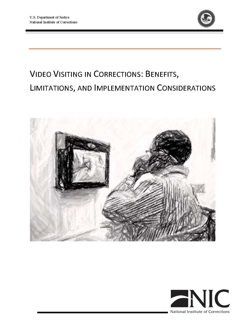Department of Justice study: Video visitation is not an invitation to ban in-person visitation
DOJ study on video visitation: In-person visits are a best practice that should be protected
by Bernadette Rabuy, January 28, 2015
In the busy days following the release of our newest report, Screening Out Family Time: The for-profit video visitation industry in prisons and jails, we stumbled upon another report on video visitation by the Department of Justice’s National Institute of Corrections, Video Visiting in Corrections: Benefits, Limitations, and Implementation Considerations. While we were unable to include the study’s findings in our report, I wanted to point out what I found to be particularly valuable.
Like our report, the DOJ breaks the industry’s products down into three categories depending on where the technology is used: home-based video visiting, facility-based video visiting, and community-based video visiting. We find this terminology to be very helpful and are thinking about using it instead of the terms we use in our report: offsite visits, onsite visits, and regional visitation centers.
I also found the benefits and limitations section to be extremely important as the study presents creative uses for video visitation systems as well as spells out why “video visiting is not for all families.”
Video visitation can:
- Expand communication options for child welfare-involved families, which can then prevent the termination of incarcerated parents’ parental rights.
- Connect incarcerated youth and their incarcerated parents who are confined in separate facilities.
- Help families stay connected when travel conditions are poor. For example, the Oregon Department of Corrections found that in-person visitation declined during the winter months.
Video visitation also has limitations:
- Families dislike facility-based video visiting because it requires the same time and expenses as traveling to a facility for an in-person visit, with none of the benefits of an in-person visit.
- Video visitation can be difficult for individuals with visual or hearing impairments or developmental delays as well as for those that that lack computer skills.
- Illiteracy may make setting up a video visitation account difficult.
- Video visitation companies’ websites may not provide scheduling instructions or customer service in multiple languages.
- Some research has found that video visitation is less effective than in-person communication. For example, research has found that an incarcerated individual’s credibility was questioned more often when the individual appeared via video for a bail or immigration hearing than if the individual appeared in-person.
Overall, the study stresses, “the value of video visiting can be maximized when the goals of the facility are balanced with the needs of incarcerated individuals and their families.” The study describes why families are dissatisfied when facility-based video visiting is their only visitation option and establishes, “Traditional in-person visiting is a best practice that should continue in all correctional settings when possible.”
The report is an especially valuable resource for state prisons and county jails considering video visitation as it includes sample checklists and surveys that should be utilized when evaluating video visitation proposals or implementing video systems.
For the report: http://nicic.gov/library/029609
For more on video visitation: http://www.prisonpolicy.org/visitation/




